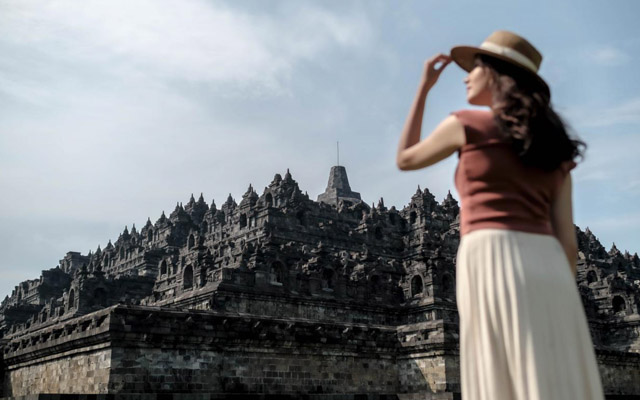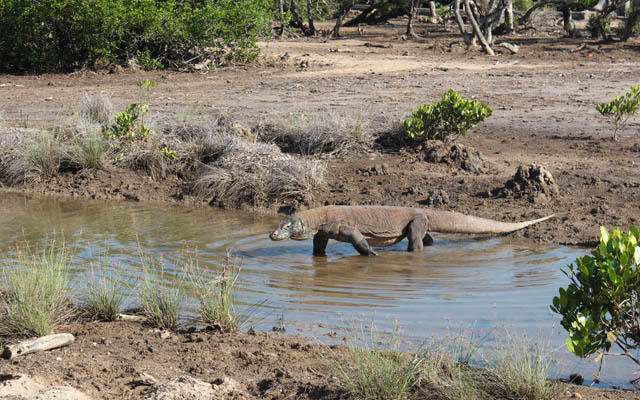- Country leaders have ordered restricted access to both Borobudur and Komodo National Park to minimise damage to the UNESCO World Heritage Sites
- Plans to substantially raise Komodo National Park entrance fees face intense trade rejection
- Tourism players urge measurable, alternative solutions for more effective conservation efforts

The Indonesian government has ordered stricter visitor controls at two iconic UNESCO World Heritage Sites – Borobudur and Komodo National Park – to ensure better protection and conservation, with measures including crowd limits and increased entrance fees.
Borobudur Conservation Center (BKB) has implemented a maximum limit of 1,200 people daily to the revered temple complex in Magelang, Central Java, along with an online registration requirement for all visitors.
Wiwit Kasiyati, head of BKB, told TTG Asia that the biggest damage to Borobudur is caused by mass tourism, which ran wild pre-pandemic. According to BKB data, visitorship to Borobudur peaked at 3.7 million people in 2019 – or 10,270 people every day.
“The large number of visitors who go up to the temple has caused rock wear and tear at a number of points. There is a sunken surface which had eroded up to five centimetres from its initial condition,” said Wiwit, adding that Borobudur also suffers from littering and vandalism.
Besides the capacity limit and pre-registration procedure, BKB has also made it a requirement for visitors to wear footwear made from natural materials to reduce damage to the temple surface. Visitors must also be accompanied by a certified tour guide.
Over at Komodo National Park, visitor management will be digitalised to facilitate online reservations while there are plans by the government to impose a full-year access entrance fee of 3,750,000 rupiah (US$250) per person. Currently, visitors to Komodo National Park pay 150,000 rupiah per person per visit on weekdays and 250,000 rupiah on weekends.
Irman Firmansyah, leader of the Ecosystem Services-Based Carrying Capacity Study Team at Komodo National Park, said the Tourism Capacity Carrying Capacity Team had recommended that the ideal number of visitors per year to Komodo Island and Padar Island was 219,000 and 39,420 respectively.
Carolina Noge, coordinator of the Function Reinforcement Program at Komodo National Park, said the revised entrance fees will help to fund a number of conservation projects, such as Komodo dragon habitat restoration, coral reef transplantation, waste management, and optimised supervision and area security to combat illegal hunting and fishing.
Not just numbers
While Indonesian travel trade players are wholly supportive of stern conservation efforts of the country’s precious heritage sites, and acknowledge that efforts will come with a number of restrictions, many have expressed doubt about the viability of higher entrance fees as a form of control.
Sugeng Sugiantoro, chairman of the Central Java Tourism Board (CJTB), said: “The mission of conservation is to convey a message to visitors about the sustainability of the site, and not to close off their access.”
He said an effective conservation policy requires clear visitor management, which must include managing both visitor behaviour and circulation.
For Borobudur, Sugeng suggested applying a tiered visitor priority system where Buddhists worshipping at the temple will be first in line for entry, followed by conservation practitioners and researchers. Finally, members of the public who had made reservations online or through travel operators would be allowed to enter.

Director of Flores Exotic Tours, Leonardus Nyoman, said a higher entrance is no guarantee that visitors would be careful with the ecosystem of a heritage site.
“It is tourist behaviour that must be changed. For example, visitors should not be allowed to bring plastic bottles and objects that trigger fires or other damages to the park,” said Leonardus, referring to Komodo National Park.
He added that a pricier admission fee was unreasonable, while an annual access was unrealistic and unnecessary.
“Most tourists only come to visit Komodo National Park once in their lifetime. It is highly unlikely that a person or group of tourists will visit more than four times in the same year. Even long-stay tourists are also unlikely to visit multiple times, as they prefer to explore other areas to get a different experience,” he said.
Private sector involvement
Rocky Pekudjawang, head of the East Nusa Tenggara Tourism Promotion Board, hopes that the government would involve the tourism industry in their conservation planning.
“This is so that the management and utilisation of heritage sites (for tourism) can be sustainable and of a higher quality,” he explained.
Private sector players, such as Sugeng and Leonardus, have plenty of ideas to improve the visitation situation at Borobudur and Komodo National Park.
Pranoto Prayitno, director of Citra Gilang Tour, suggested another solution that takes some of the spotlight off the iconic sites. For example, instead of taking visitors to Borobudur, tour programmes can showcase sunrise over Borobudur from Punthuk Setumbu, a small hill located about three-kilometres west of the temple complex.
“Visitors can also enjoy Borobudur in a tourist village where they will learn about the historical value of the temple through the eyes of local residents,” Pranoto added.
There is also the possibility of establishing alternative tourism around Borobudur, such as other hidden-gem temples.
“Visitors can go on a safari to visit temples or villages, plow the fields, and catch eels,” he said.




















